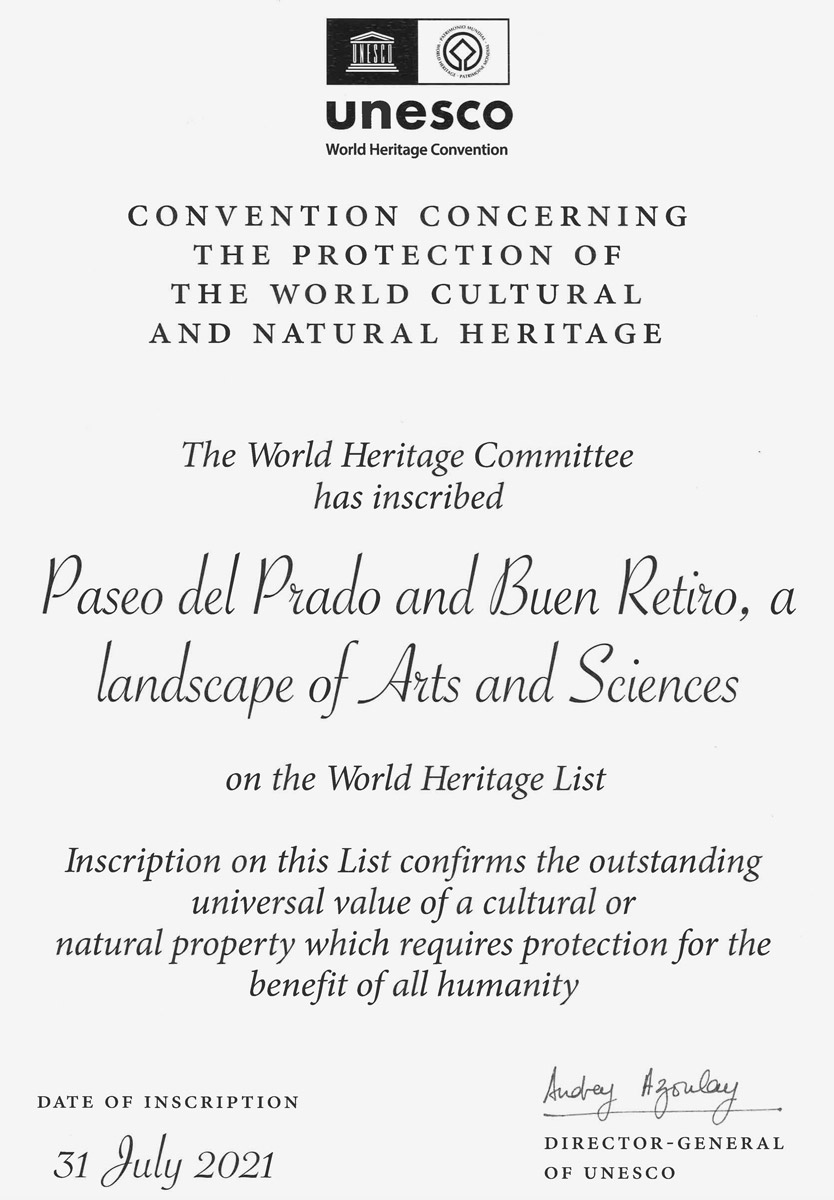![]()



Madrid is now inscribed on the World Heritage List. In 2019, Spain submitted the Paseo del Prado and Buen Retiro, Landscape of Arts and Sciences to UNESCO as a candidate to be inscribed on the World Heritage List, and UNESCO approved the nomination in 2021. Indeed, this area is an extraordinary urban landscape that has combined culture and nature since the mid-16th century, resulting in its Outstanding Universal Value status.
UNESCO’s World Heritage List includes sites of outstanding universal value. This list was created in 1972 by the Convention Concerning the Protection of the World Cultural and Natural Heritage to protect heritage considered important for all humanity and worthy of preservation for present and future generations.
Each year, countries submit candidacies which are examined in detail. UNESCO’s World Heritage list consists of more than 1,100 sites worldwide. Spain, with a total of 49, is one of the countries with the highest number of listed sites, along with Italy and China. Each year, countries submit nominations which are examined in detail and voted on by the World Heritage Committee.

Management bodies
- The Civic and Social Council is a participatory body comprising institutions, entities, foundations, and associations with a legitimate interest in the Landscape of Light. It convenes in sectoral working groups whose proposals are submitted to the plenary of the council for approval. Work is currently in progress on its new legal status, which will be that of an Association. The actions resulting from this initiative will be shared and tracked in an online database.
- The World Heritage Commission comprises the Madrid City Council, the Community of Madrid, and the Ministry of Culture and Sport and is responsible for liaising with UNESCO.
- The Scientific Council comprises experts in various fields chosen for their extensive professional experience and knowledge in World Heritage matters.




Top: close-up of entrance atrium of the Real Observatorio de Madrid. Bottom: Parterre del Retiro. Bottom left: sculpture of Francisco de Goya at the entrance to Museo Nacional del Prado. Right: view of the Jardines del Buen Retiro from the Monumento al rey Alfonso XII. Bottom: full view of The Landscape of Light, showing the enormous green patch of the Jardines del Buen Retiro in the centre.
The World Heritage Designation
Paseo del Prado and Buen Retiro, a Landscape of Arts and Sciences
The World Heritage property includes the Paseo del Prado, Retiro Park, and the surrounding area. It has been inscribed on the UNESCO World Heritage List as a Cultural Landscape; a landscape of outstanding value that man has shaped throughout history.
The Paseo del Prado and Buen Retiro, Landscape of the Arts and Sciences, Landscape of Light, was the first tree-lined boulevard in a European capital. It was created in the 16th century to provide the inhabitants of Madrid with a space for leisure and relaxation in a tree-lined environment.
History
In 1570, Philip II decided to develop the area of orchards and streams on the outskirts of Madrid, known as Prado Viejo, opposite the monastery of San Jerónimo El Real. The king lined the new promenade with rows of trees and ordered the construction of several fountains that drew water from nearby streams. The new, renovated Prado harmoniously marked the city’s boundary and became a new recreational area for the citizens.
Since its foundation, the monarchs occasionally spent time at the monastery of San Jerónimo El Real, where they even had their own special quarters, known as the royal quarters. Philip IV, supported by the Count-Duke of Olivares, commissioned an exceptional project in the royal quarter: the Buen Retiro Palace and its gardens, which we preserve today under the name of Retiro Park.
In the 18th century, Charles III, guided by the Enlightenment, reformed the area and created the Salón del Prado. José de Hermosilla oversaw the urban redevelopment of the Prado Viejo, and Ventura Rodríguez designed the new fountains for the Salón del Prado: Cybele, Apollo and Neptune.
In the early 19th century, the War of Independence wreaked havoc on the Buen Retiro Palace and its gardens, which were used as barracks. The palace was razed to the ground, except for a few buildings that have survived to the present day, such as the Casón del Buen Retiro and the Salón de Reinos.
The restoration of the Buen Retiro gardens began during the reign of Ferdinand VII. Isidro González Velázquez was in charge of this project, which included several landscaping follies such as the Casita del Pescador (Fisherman’s House), the Montaña Artificial (Artificial Mountain) and the Fuente Egipcia (Egyptian Fountain).
In 1868, Retiro Park was transferred to municipal ownership. This new public ownership led to the Retiro hosting various events and exhibitions; the Crystal Palace and the Velázquez Palace, both by Ricardo Velázquez Bosco, are some of the architectural testimonies of this period.
The inscription of the Paseo del Prado and Buen Retiro, a Landscape of Arts and Sciences, “Landscape of Light”, in the World Heritage List is a universal recognition of the history of this distinguished cultural landscape of Madrid.
Documents relating to the Landscape of Light in the Memory of Madrid Digital Library
The Memory of Madrid Digital Library is a project aimed at promoting the memory of the city through the digitisation of the Madrid City Council’s historical heritage, especially items preserved in its archives, museums, and libraries. Visitors can access photographs, newspapers and magazines, postcards, books from the 16th to the 20th centuries, objects from museums, etc. All these elements provide helpful information to understand the evolution of the city and Madrid’s cultural life.
Given its significance and relevance, the Memory of Madrid Digital Library is the municipal institution that houses all the instantly accessible digital documentation associated with the Landscape of Light.



